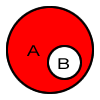The UNION of two sets is the set of elements which are in either set.
For
example: let A = (1,2,3) and let B = (3,4,5). Now the UNION of A and B,
written A ![]() B = (1,2,3,4,5). There is no need to list the 3 twice.
B = (1,2,3,4,5). There is no need to list the 3 twice.
The INTERSECTION of two sets is the set of elements which are in both sets.
For example: let A
= (1,2,3) and B = (3,4,5). The INTERSECTION of A and B, written A ![]() B = (3).
B = (3).
Sometimes there will
be no intersection at all. In that case we say the answer is the "empty
set" or the "null set![]() "
"
![]() .
.
For example: Given
set
A =![]() all
prime numbers greater than 5
all
prime numbers greater than 5![]() and set B=
and set B= ![]() all
even prime numbers
all
even prime numbers![]() ,
,
then A ![]() B =
B = ![]() .
.
Now
sometimes we want to talk about elements which lie OUTSIDE of a given
set and within another set. This is referred to as finding the COMPLEMENT
of the set and is written for example, ![]() B.
B.
In
the picture, the red shaded region would represent the complement of set
B, ![]() B.
B.

Click HERE to enter a world made entirely of Intersections, Unions and Complements. We call it Venn World. You are welcome to help it grow by creating characters your own characters. Our guide the EGG MAN will explain how it is done.
